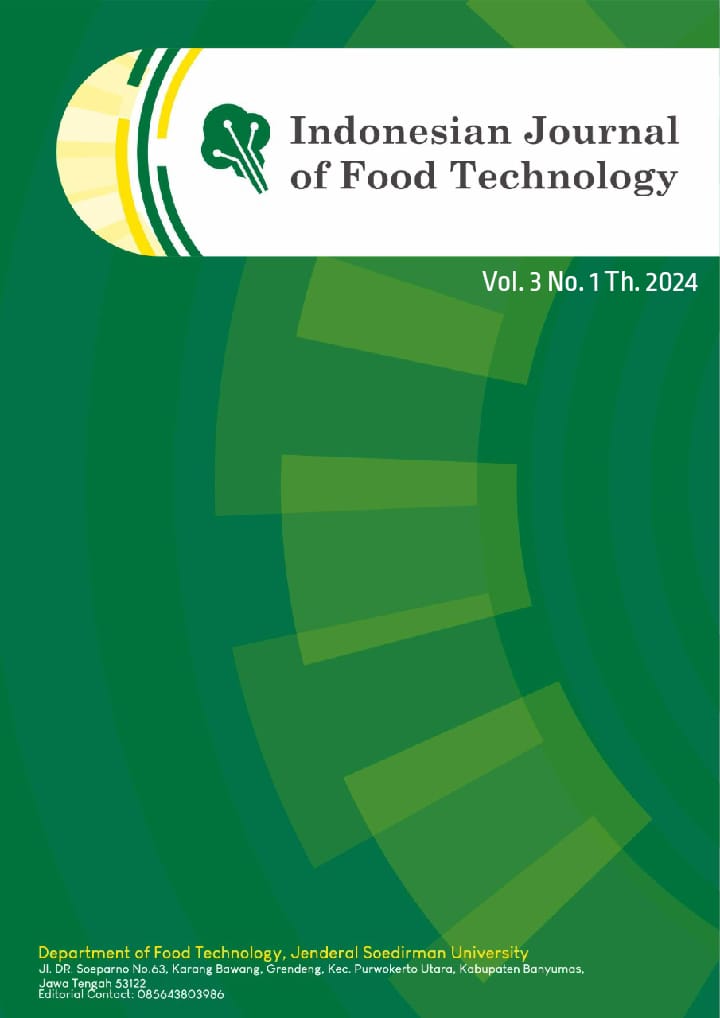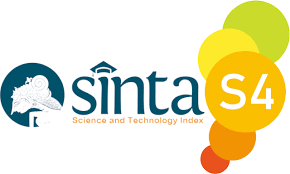Chemical and Organoleptic Characteristic Banana Stem Chips Made from Kepok Banana (Musa Acuminata sp.) and Raja Banana (Musa acuminata sp.)
Abstract
The potential for banana stems to be processed into food products is very large, considering that their utilization is still low so far. One of the processed foods that is popular with the public is chips. Chips have been produced from various types of tubers, but industries that process banana stems into chips are still very rare. If processed properly, banana stem chips can provide quite large profit opportunities. Banana stem chips have a high fiber content which makes them unique as a variety of snacks to meet dietary fiber needs. This study aims to obtain a combination of types of bananas with soaking time using salt, which can produce banana stem chips with the best fiber, water, ash and organoleptic content. The research design used a randomized block design with the first treatment being the type of banana stem (kepok and plantains) and salt concentration (2, 4, and 6%). Variations in the treatment of giving salt baths with levels of 2%, 4% and 6%. The best treatment was P1K3, which was a type of kepok banana soaked in 6% salt with chemical characteristics of 16.98% fiber content, 4.56% moisture content, 0.77% ash content. The organoleptic test showed that the average consumer expressed a real level of liking with a texture value of 4.70; aroma of 4.67; color of 4.63; and taste of 4.64.
References
Arifki, H.H dan Barliana, M.I. 2018. Karakteristik dan Manfaat Tumbuhan Pisang di Indonesia: Riview Artikel. Jurnal Farmaka. 16 (3): 196 – 203.
Deglas, W. 2018. Kajian Karakteristik Sifat Fisiko Kimia dan Organoleptik Keripik Singkong Variasi Konsentrasi Larutan Natrium Bikarbonat (NaHCO3) Dengan Proses Pendahuluan. Jurnal Teknologi Pangan Vol 9 (2): 157-163.
Dwivany, F. M., dkk. 2021. Pisang Indonesia. ITB Press. Bandung. Hal 17 – 25
Hala, Y., dkk. 2022. Pemanfaatan Sumber Daya Desa dengan Pengelolahan Batang Pisang menjadi Keripik. Jurnal Pengabdian Multidisiplin. 4 (1): 30 – 37.
Irmayanti, Irhami. 2022. Pengaruh Konsentrasi Kalsium Hidroksida (Ca(OH)2 dan Waktu Perendaman Terhadap Kualitas Keripik Bonggol Pisang Wak. Serambi Jurnal Teknologi Pertanian. Vol. 4 (1) : 8 – 6.
Jamaluddin, P. 2018. Pengelolahan Aneka Kerupuk dan Keripik Bahan Pangan. Badan Penerbit UNM. Makassar.
Maligan, J. M., dkk. 2011. Keripik Umbi Inferior Aneka Bentuk dan Rasa. Pengabdian Masyarakat. Fakultas Teknologi Pertanian. Universitas Brawijaya. Malang.
Munte, S. I., dkk. 2008. Keripik Dari Batang Muda Pisang yang Bernilai Serat Tinggi. Laporan Akhir Program Kreativitas Mahasiswa. Institute Pertanian Bogor. Bogor
Putri, B. A. 2021. Nilai Ekonomis Batang Pisang Sebagai Alternatif Pendapatan Masyarakat. Skripsi. Institut Agama Islam Negeri Bengkulu. Bengkulu.
Rosariastuti, R., dkk. 2018. Pemanfaat Batang Pisang untuk Aneka Produk Makanan Olahan di Kecamatan Jenawi, Karanganyar. Jurnal Prima. 2 (1): 21 – 29.
Saragasi, B. 2013. Analisis Mutu Tepung Bongol Pisang dari Berbagai Varietas dan Umur Panen yang Berbada. Jurnal Teknologi Boga dan Busana. Vol. 9(1):22-29
Sianita, dkk. 2021. Analisa Kadar Air, Kadar Asam dan Masa Simpan Produk Keripik Tahu Walik. Dalam Kumpulan Makalah Prosiding Seminar Nasional Kimia FMIPA UNESA. Surabaya











